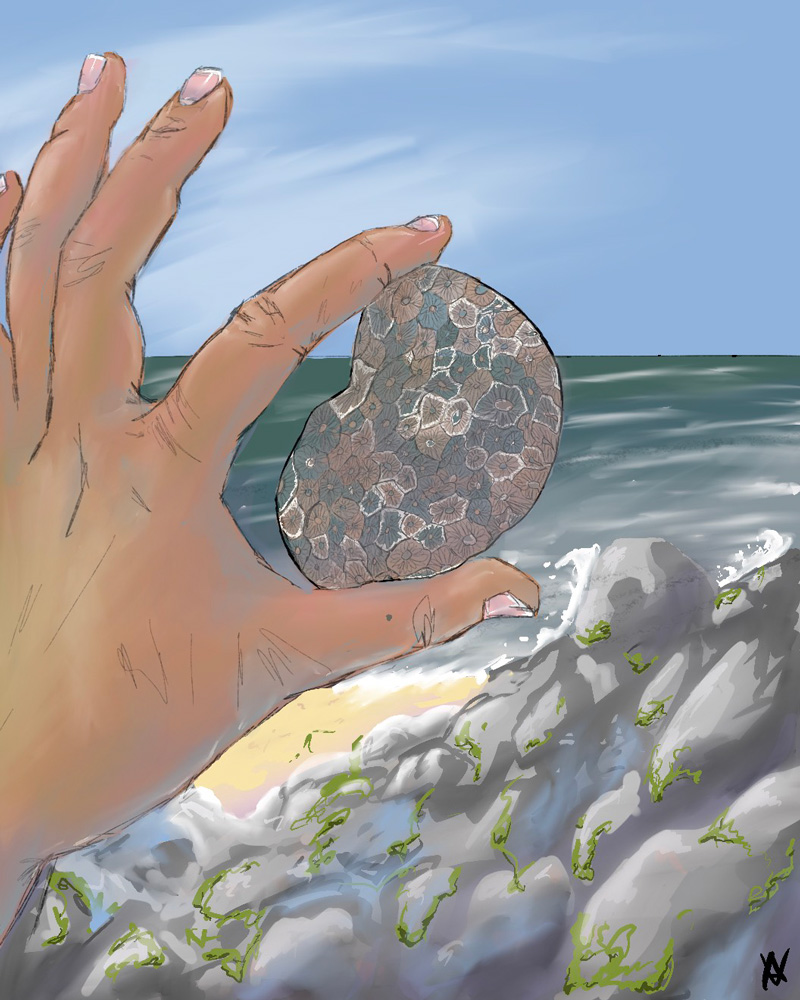by Gabe Gross
Something very special and unusual might be at your fingertips—you just need to know how to spot it.
Divine, glamorous, and beautiful–what are these? They are all traits of the Petoskey stone, a Midwestern beach surprise few are familiar with. Rock hunting is a favorite activity on my annual family trip to Michigan. Let’s look at some interesting treasures on display up north, as well as how to find them!
The scientific name of the Petoskey Stone is “Hexagonoria Percarinata.” Millions of years ago in Lake Michigan, warm reefs held many creatures and corals. During the process of glaciation, ice sheets ripped rocks from the bedrock layer, depositing them into Lake Michigan. This turned the Hexogonoria into the Petoskey Stone, which was named Michigan’s state stone in 1965. To this day, if you look hard enough, you’ll find Petoskey Stones on beaches just a half day’s drive from Peoria. If you find one in the water, it glistens, revealing a distinctive pattern of coral.
Another natural treasure found in Michigan looks like a rock but is actually a substance called “slag.” A beautiful blue color, it is referred to as a “Leland Blue.” You can’t find a Leland Blue on just any beach in Michigan. You must travel north up the Leelanau Peninsula to the town of Leland. Located in Northern Michigan, it was a diverse iron ore mining area. During the mining process, the ore was heated to extreme temperatures and mixed with other products. Sometimes these products created rich and dense colors, finding their way into sediment as in the case of the Leland Blue.
To have success in discovering a Petoskey or a Leland Blue, you need a sense of adventure. Rock hunting and sand dune climbing go hand in hand. Many Petoskey Stones are found on a secret beach at the end of the challenging Sleeping Bear Dunes hike. This is a long, difficult hike taking an average of up to four hours. Only the most dedicated and adventurous can tolerate the hot sand under their feet, persisting to climb dune after dune. Along the way, at the top of each dune, I feel accomplished, sun in my face, looking out at the fabulous shimmering waters of Lake Michigan. The reward—my favorite part—is the cool fresh water at the end.
You might have to climb dunes that are steep plummets, a popular spot being Scenic Overlook Drive. Most vacationers are there to see the view, but the more adventurous traveler descends to Lake Michigan. A highlight of going down is to experience the crystal-clear water, which feels so refreshing after being on the hot dry sand.
Pyramid Point is a huge sand dune and to hike it you need to start at the top. If you are willing to climb down the steep plummet, make sure you’re strong enough to get back up the mile high summit! At the bottom you can find lots of Petoskey Stones as you walk the beach. Be careful though, if you take too many, you will have trouble making it back up the dune.
Michigan is a great destination for rock hunting. If you visit the right beaches, you could return with a dazzling treasure.
About Gabe Gross

Gabriel Gross is an eighth grader at St. Thomas school in Peoria Heights. He is the Student Council president. He plans to go to Richwoods and apply for the IB program. He loves baseball, basketball, and traveling. He also enjoys learning about history and how much it has changed our lives today.
About Adrien Vozenilek

Adrien Vozenilek is a freshman at Southern Illinois University in Edwardsville. They are currently double majoring in Psychology and Art. Adrien’s art is focused on their family and Italian heritage. They hope to work as an art therapist for LGBTQIA+ youth. You can find their Instagram at @a_vozenilek.

